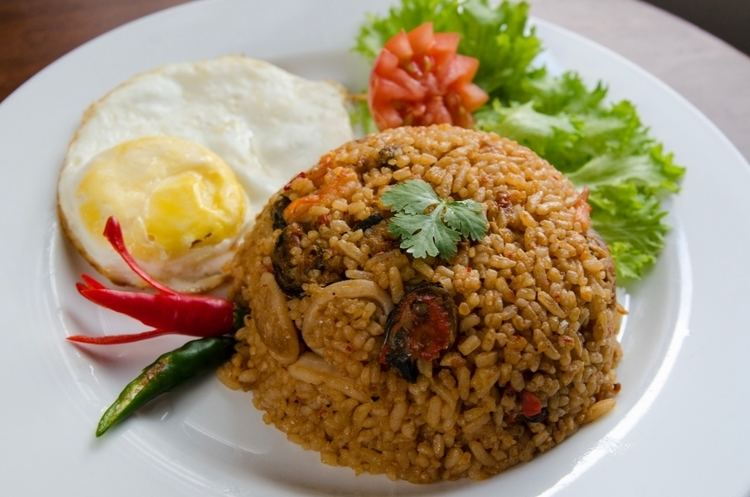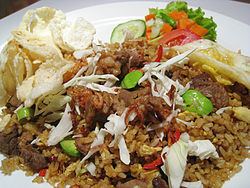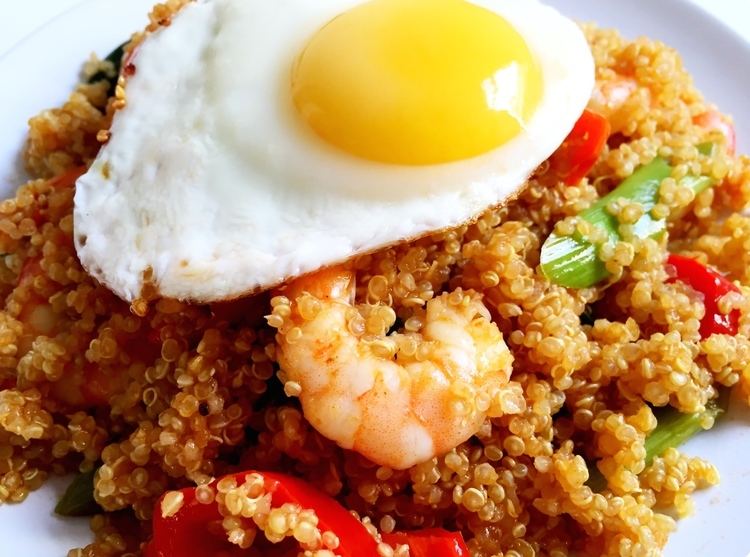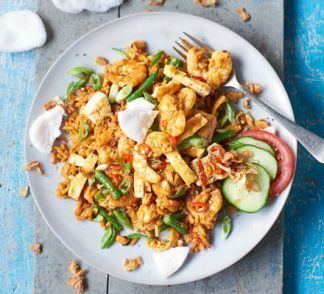Course Main course Origin Indonesia | Place of origin Indonesia Serving temperature Hot | |
 | ||
Region or state Nationwide in Indonesia, Malaysia, Singapore and Brunei; also popular in Southern Thailand, Sri Lanka, Suriname and the Netherlands Main ingredients Fried rice with meats, vegetables and spices, usually seasoned with sweet soy sauce Similar Cooked rice, Mie goreng, Sambal, Bumbu, Satay | ||
Nasi goreng indonesian fried rice recipe
Nasi goreng, literally meaning "fried rice" in Indonesian and Malay, can refer simply to fried pre-cooked rice, a meal including stir fried rice in small amount of cooking oil or margarine, typically spiced with kecap manis (sweet soy sauce), shallot, garlic, ground shrimp paste, tamarind and chilli and accompanied by other ingredients, particularly egg, chicken and prawns. There is also another kind of nasi goreng which is made with ikan asin (salted dried fish) which is also popular across Indonesia. Nasi goreng is sometimes described as Indonesian stir-fried rice, although it is also popular in Malaysia, Singapore and Brunei. Beyond the Malay Archipelago, it has gained popularity through Indonesian influence in Sri Lanka and via Indonesian immigrant communities in Suriname and the Netherlands. It is distinguished from other Asian fried rice recipes by its aromatic, earthy and smoky flavor, owed to generous amount of caramelized sweet soy sauce and powdered shrimp paste, and the taste is stronger and spicier compared to Chinese fried rice.
Contents
- Nasi goreng indonesian fried rice recipe
- Street food indonesia fried rice nasi goreng
- History
- Ingredients
- Condiments
- Variations
- Indonesia
- Malaysia Singapore and Brunei
- The Netherlands
- Homemade
- Street vendor
- Restaurant
- Convenience store
- In popular culture
- Gallery
- References

Nasi goreng has been called the national dish of Indonesia, though there are many other contenders. It can be enjoyed in simple versions from a tin plate at a roadside food stall, eaten on porcelain in restaurants, or collected from the buffet tables of Jakarta dinner parties.

In 2011 an online poll by 35,000 people held by CNN International chose Indonesian nasi goreng as the number two of their 'World’s 50 Most Delicious Foods' list after rendang.

Street food indonesia fried rice nasi goreng
History

Nasi goreng had the same beginnings as other versions of fried rice; as a way to avoid wasting rice. Frying the rice could prevent the propagation of dangerous microbes, especially in pre-refrigeration technology Indonesia and Malaya, and also avoid the need to throw out precious food. Nasi goreng is traditionally served at home for breakfast and it is traditionally made out of leftover rice from the night before. Besides ingredients like shallot, tomato, pepper and chili, the rice is fried with scraps of chicken or beef; usually leftovers from a chicken or beef dish.

Nasi goreng is often described as Indonesia's twist on fried rice. And as with other fried rice recipes in Asia, it has been suggested that it can trace its origin from Southern Chinese fried rice. However, it is not clear when Indonesians began to adopt the Chinese fried rice and create their own version. The Chinese influences upon Indonesian cuisine can be seen in mie goreng that appeared simultaneously with the introduction of the stir frying technique that required the use of a Chinese wok. The trade between China and the Indonesian archipelago flourished from the era of Srivijaya around the 10th century and intensified in the Majapahit era around the 15th century. By that time Chinese immigrants had begun to settle in the archipelago, bringing along with them their culture and cuisine. Chinese people usually favor freshly cooked hot food, and in their culture it is taboo to throw away uneaten foodstuffs. As a result, the previous day's leftover rice was often recooked in the morning. Previously, Indonesians probably simply sun-dried the leftover rice to make intip or rengginang (rice cracker), the dried rice also could be ground to make rice flour.

Nasi goreng is ubiquitous in Indonesia, and also popular in neighboring Malaysia and Singapore, as well as the Netherlands through its colonial ties with Indonesia. Today microwave-heated frozen nasi goreng is available in convenience stores, such as 7-Eleven and Lawson in Indonesia.
Ingredients
Nasi goreng is distinguished from other Asian fried rice recipes by its aromatic, earthy and smoky flavour, owed to generous amount of caramelized kecap manis (sweet soy sauce) and ground powdered terasi (shrimp paste), and the flavour is stronger and spicier compared to Chinese fried rice. Nasi goreng often includes krupuk and bawang goreng (fried shallots) or (fried onions) to give a crispier texture.
The main ingredients of nasi goreng include pre-cooked rice, sweet soy sauce, powdered terasi (shrimp paste), salt, garlic, shallot, chilli pepper, spring onions, nutmeg, turmeric, vegetable oil, onions, palm sugar, ginger garlic paste, and slices of cucumber and tomato for garnishing. Some recipes may add black pepper, fish sauce, or powdered broth as a seasoning and taste enhancer. Eggs might be mixed into fried rice or fried separately, either as telur ceplok/telur mata sapi (sunny side up eggs), or telur dadar (omelette), and also telur rebus (boiled eggs). Originally optional, the addition of fried egg is often named as nasi goreng spesial (pakai telur) or special fried rice topped with fried egg.
Condiments
Nasi goreng often add condiments as add-on upon the fried rice. Fried shallot and traditional crackers are often sprinkled upon to give crispy texture, pickles are added to give sour freshness in otherwise rather oily dish, while chili paste is to add the zesty spiciness according to one's preference. Some common condiments are:
Variations
There is no single recipe of nasi goreng, as every fried rice dish with certain mixtures, additions, ingredients, and toppings could lead to another recipe of nasi goreng. Usually, in Indonesian households, the ingredients of nasi goreng prepared for daily breakfast are the leftovers of the previous day's meals preserved in the refrigerator, with fresh vegetables and eggs added. The basic ingredients of nasi goreng are rice and sliced or ground bumbu (spices) mixture of shallot, garlic, pepper, salt, tomato ketchup, sambal or chili sauce, and usually sweet soy sauce. Some variants may add saus tiram (oyster sauce), ang-ciu (Chinese cooking red wine), kecap ikan (fish sauce), or kecap inggris (like Worcestershire sauce). The texture of leftover cooked rice is considered more suitable for nasi goreng than that of newly cooked rice, as freshly cooked rice is too moist and soft.
Nasi goreng is known as fried rice variants commonly found in Indonesia, Malaysia, Singapore and Brunei. Despite myriad specific regional variants, it is notable that certain recipe appears in multiple countries, kampung (village), shrimp paste, sambal, salted fish and egg-wrapped fried rices are appears in both Indonesia and Malaysia. There are similar fried rice dishes from neighboring countries, such as khao phat from Thailand, and sinangag from the Philippines.
Indonesia
In most parts of Indonesia, nasi goreng is cooked with ample amounts of kecap manis (sweet soy sauce) that created golden brownish color and the flavour is mildly sweet. However, in other places such as Eastern Indonesia (Sulawesi and Maluku), the sweet soy sauce are usually absent and replaced by bottled tomato and chili sauce, creating reddish-colored nasi goreng. This variant is called nasi goreng merah (red fried rice) or nasi goreng Makassar after the South Sulawesi capital. Some variants of nasi goreng, such as salted fish or teri Medan (Medan's anchovy) nasi goreng, are not using kecap manis at all, creating lighter color similar to Chinese fried rice or Japanese chahan.
Nasi goreng Kambing Kebon Sirih is one of a popular variant of goat meat fried rice sold in Kebon Sirih area, Central Jakarta. While nasi goreng amplop is fried rice "enveloped" inside thin omelette skin, almost identical to Malaysian nasi goreng pattaya.
The most common nasi goreng usually uses chicken and egg, however, some variants are usually named after its additional ingredients. Examples of nasi goreng specific variants includes:
Indonesians also called foreign versions of fried rice simply as nasi goreng, thus nasi goreng Hongkong and nasi goreng Tionghoa/China refer to Chinese fried rice, while nasi goreng Jepang refer to yakimeshi or chahan.
Malaysia, Singapore and Brunei
Nasi goreng is a commonly popular household dish in Malaysia, Singapore and Brunei. It is also can be found in restaurants and food courts in the country. In Brunei, nasi goreng ikan masin (fried rice with salted fish) is the most popular version.
Nasi goreng variants popular in Malaysia, Singapore and Brunei includes:
However, since Malaysia and Singapore has significant Overseas Chinese community, Chinese fried rice recipes, such as Yeung Chow fried rice are also popular, next to local nasi goreng belacan.
The Netherlands
In the Netherlands, Indonesian cuisine is common due to the historical colonial ties with Indonesia. Indonesian migrants (or their offspring) cater Indonesian food both in restaurants and as take-away. Also, take-away versions of nasi goreng are plentiful in toko Asian grocery shop and supermarkets. Supermarkets also commonly carry several brands of spice mix for nasi goreng, along with krupuk and other Indonesian cooking supplies. Chinese take-aways and restaurants have also adapted nasi goreng, plus a selection of other Indonesian dishes, but spice them Cantonese style. In Flanders, the name nasi goreng is often used for any Asian style of fried rice. Distinctive version of nasi goreng has been developed, such as Javanese-Suriname version of the dish. In the Netherlands, nasi goreng has been developed into snack called nasischijf (Dutch for "rice disk"), it is a Dutch deep-fried fast food, consisting of nasi goreng inside a crust of breadcrumbs.
Homemade
Nasi goreng can be eaten at any time of day, and many Indonesians, Malaysians and Singaporeans eat nasi goreng for breakfast. In most of households, last night leftovers stored in refrigerator are often used to create nasi goreng for breakfast; such as chunks of chicken, shrimp, vegetables, fish, beef, bakso or sausages. The rice used to make nasi goreng is cooked ahead of time and left to cool down (so it is not soggy), which is one reason to use rice cooked from the day before.
Street vendor
While most Indonesian households serve it for breakfast, nasi goreng is also a popular choice for late night supper served by street vendors, in warungs and also by travelling night hawkers that frequent Indonesian residential neighborhoods with their wheeled carts. The nasi goreng is usually cooked on order for each serving, since the cook usually asks the client their preference on the degree of spiciness: mild, medium, hot or extra hot. The spiciness corresponds to the amount of sambal or chili pepper paste used. The cook might also ask how the client would like their egg done: mixed into nasi goreng or fried separately as telur mata sapi or ceplok (fried whole egg) or as telur dadar (omelette). The term spesial pakai telur means the nasi goreng has two eggs per serving, one mixed into the nasi goreng as scrambled egg, another fried separately. As well as offering nasi goreng, the travelling nasi goreng cart vendors usually also serve mi goreng, mi rebus, and kwetiau goreng. Nasi goreng usually made by order, nevertheless, some popular nasi goreng warung or food stall might cook them in bulk, due to large demand. The degree of spiciness is applied by customer through the addition of sambal hot sauces.
Restaurant
Nasi goreng is a popular dish in Indonesian restaurants and Asian fusion restaurants. It is often served for breakfast in Indonesian hotels. In Indonesian restaurants, the dish is often served as a main meal accompanied by additional items such as a fried egg, ayam goreng (fried chicken), satay, vegetables, seafoods such as fried shrimp or fish, and kerupuk (meaning crackers, also called "prawn crackers" and many other names). Although traditionally nasi goreng is seldom consumed with satay nor fried chicken, in many Indonesian restaurants abroad this combo is quite popular—in order to allow clients to sample quintessential Indonesian dish; nasi goreng and satay in single serving.
In many warungs (street stalls), when accompanied by a fried egg, it is sometimes called nasi goreng istimewa (special fried rice). Nasi goreng is usually sold together with bakmi goreng (fried noodles) and mie rebus (noodle soup). They sell a simple nasi goreng with small amount of shredded fried chicken, scrambled egg, green vegetables, and served with pickled cucumber.
Convenience store
Some seasoning brands sold in supermarkets, such as Sajiku-Ajinomoto, Racik, LaRasa, Royco and Kokita offering "bumbu nasi goreng", an instant nasi goreng seasoning paste to be applied upon frying leftover rice. Today the modern convenience stores such as 7-Eleven and Lawson operated in Indonesia also offering prepackage frozen microwave-heated nasi goreng take away.
